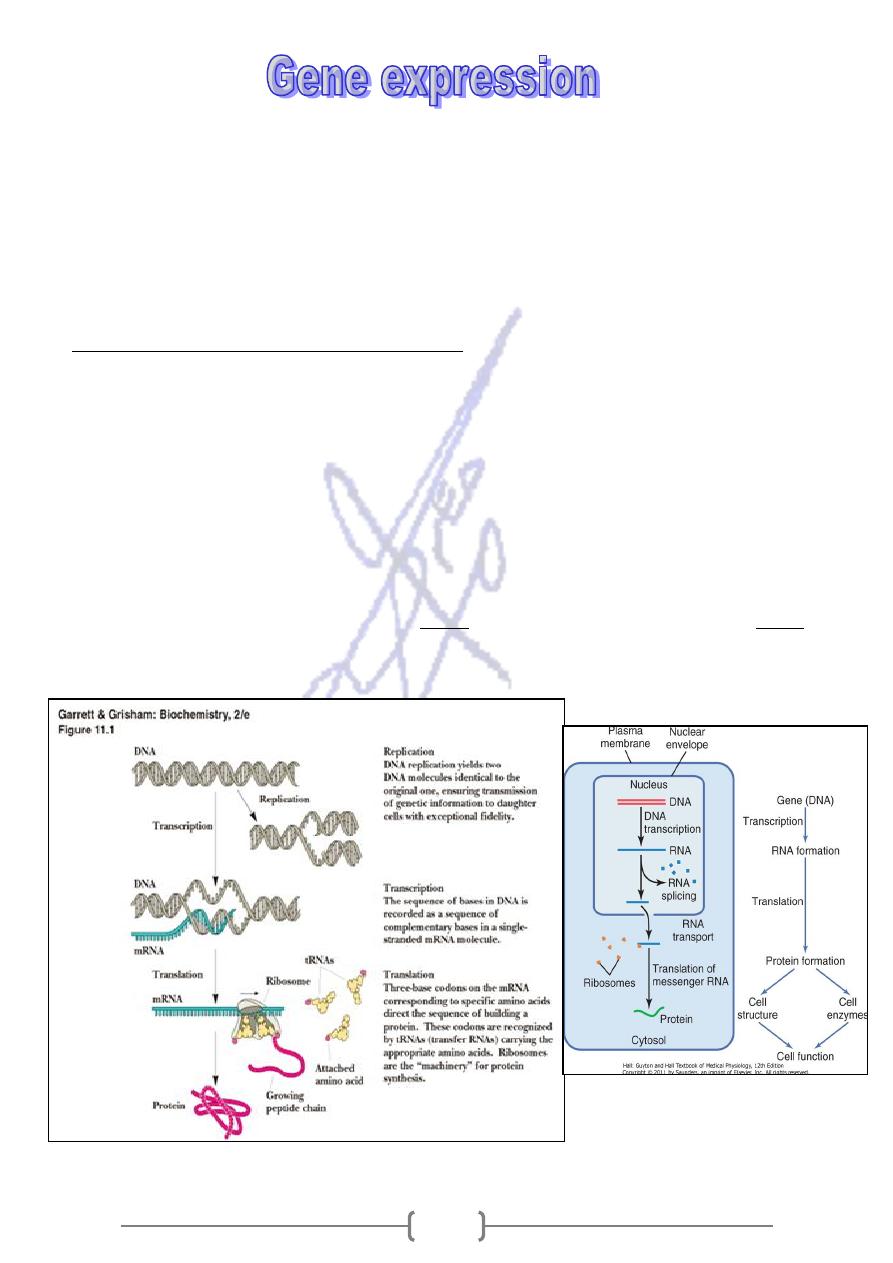
93
*
The expression of genetic information in all cells is a one- way system:
* Because of its universality, the DNA to RNA to protein flow of genetic information has been
described as the central dogma of the molecular biology.
* The information contained in DNA must be transported to the cytoplasm and then used to
form the composition of protein.
translation.
and
transcription
Gene expression involves two processes,
*
In general, RNA is a helper to DNA, allowing protein synthesis to occur according to the genetic
information that DNA provides.
1- The first step transcription is the process of synthesis RNA using: a DNA template and DNA-
dependent RNA polymerase enzyme.
* It occurs in the nucleus of eukaryotic cells and to a limited extent, in mitochondria
2- The second step translation, is polypeptide synthesis occurs in ribosomes, large RNA-
protein complexes which are found in the cytoplasm and also in mitochondria.
* Both processes mediated by ribonucleic acid (RNA), a single- stranded nucleic acid that is
uracil
sugar rather than deoxyribose, and
ribose
chemically similar to DNA, except that it has
base rather than thymine.
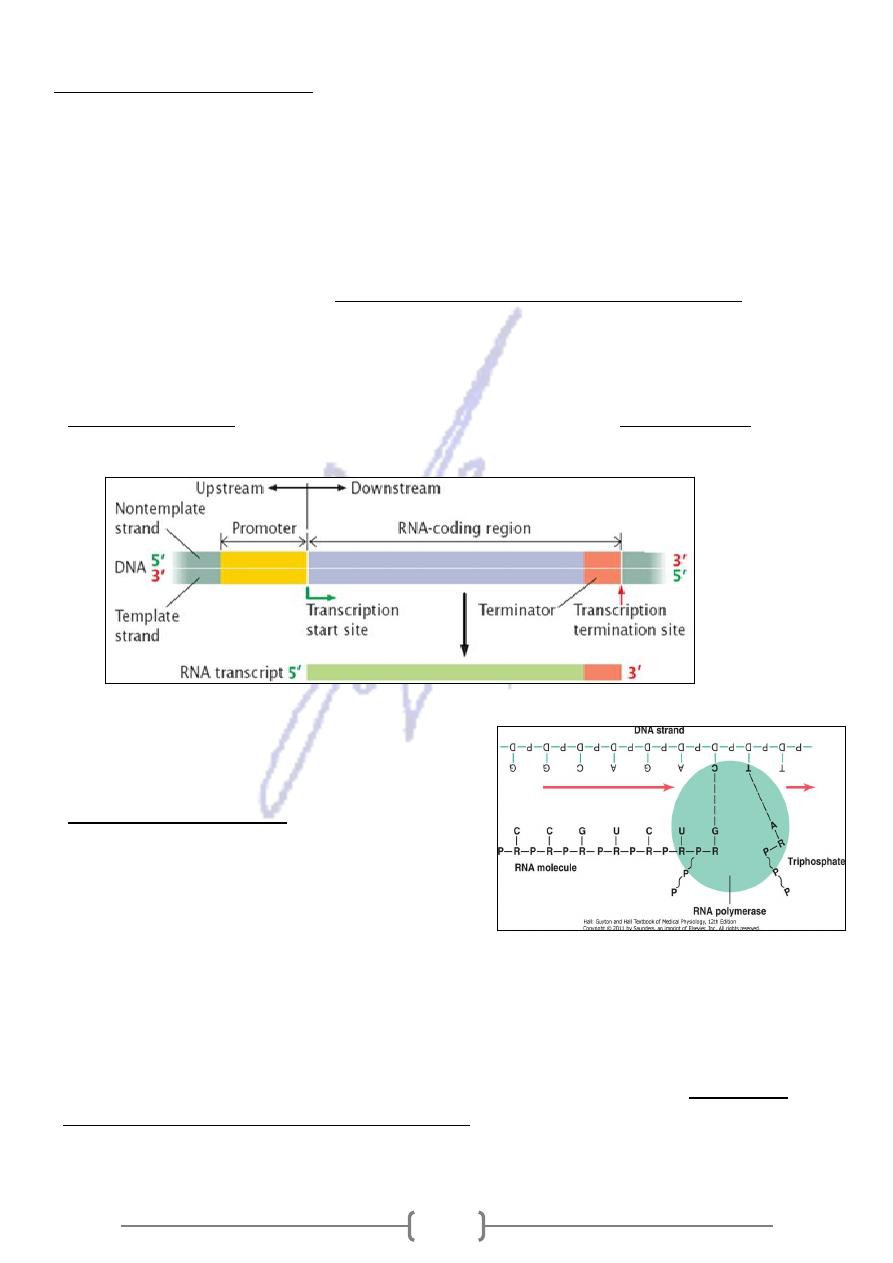
94
Transcription of RNA
Transcription is the process by which RNA sequence is formed from a DNA template. The type of
RNA produced by the transcription process is messenger RNA (mRNA).
* To initiate mRNA transcription, one of the RNA polymerase enzymes (RNA polymerase II)
binds to a promoter site on the DNA
- (a promoter is a nucleotide sequence that lies just upstream of a gene).
* The RNA polymerase then pulls a portion of the DNA strands apart from one another,
for
One of the two DNA strands provides the template
exposing unattached DNA bases.
the sequence of mRNA nucleotides.
* RNA polymerase moves from 3' to 5' direction along the DNA template strand,
assembling the complementary mRNA strand from 5' to 3' (except that U replace T).
is
template strand
, and the
sense strand
of the double helix called
non template strand
*
called the antisense strand.
* Soon after RNA synthesis begins, the 5' end of the
growing RNA molecule is "capped" by addition of a
chemically modified guanine nucleotide.
:
appears to help
5' cap
The
*
A. prevent the RNA molecule from being degraded
during synthesis, and
B. later helps to indicate the starting position for
translation of the mRNA molecule into protein
* Transcription continues until a group of bases called a termination sequence is
reached.
Near this point a series of 100- 200 adenine bases are added to the 3' end of the RNA
molecule. This structure is called as the poly- A tail, may be involved in stabilizing the mRNA
DNA strands
the cytoplasm. Finally the
molecule so that it is not degraded when it reaches
, leaving a transcribed single mRNA strand.
and the RNA polymerase separate from RNA strand
* This mRNA molecule is termed the primary transcript.
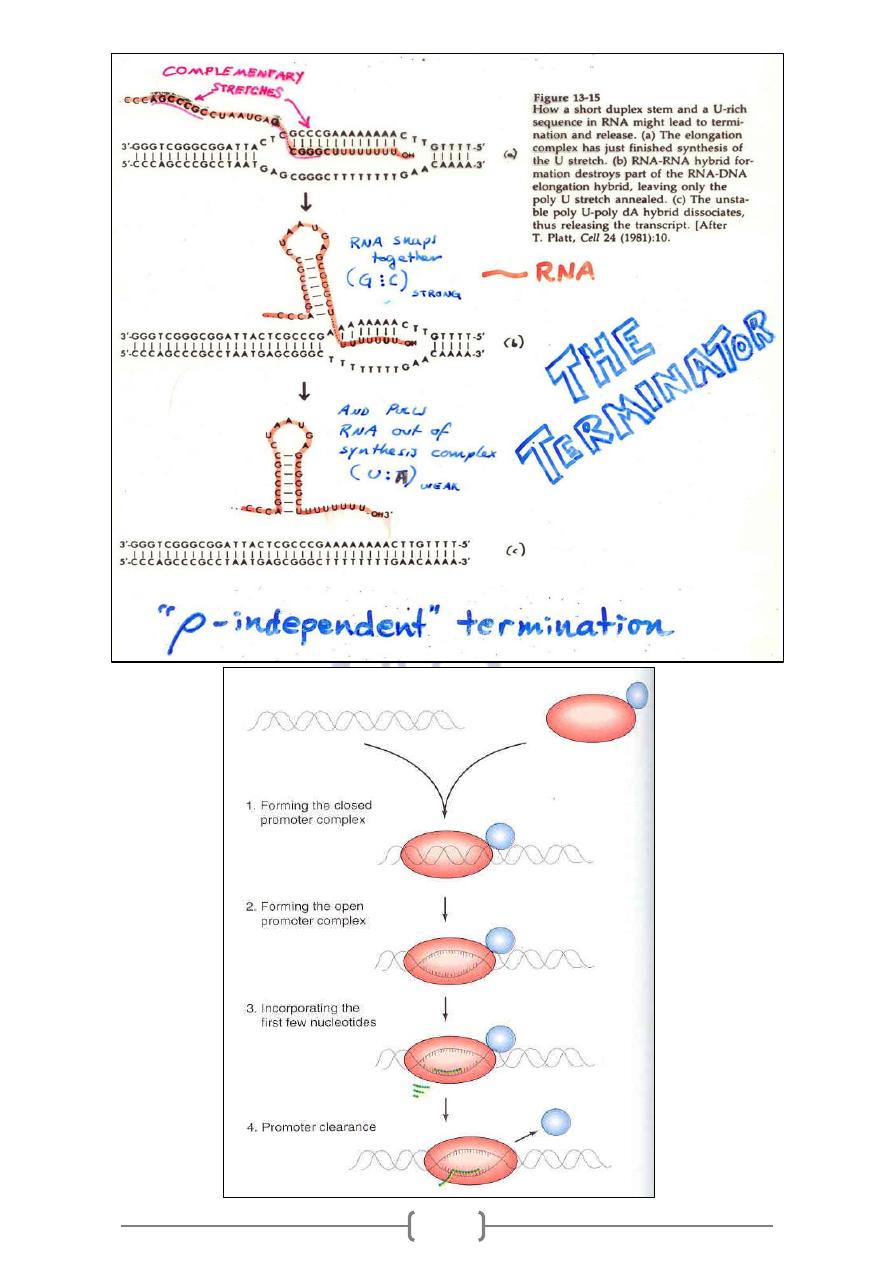
95
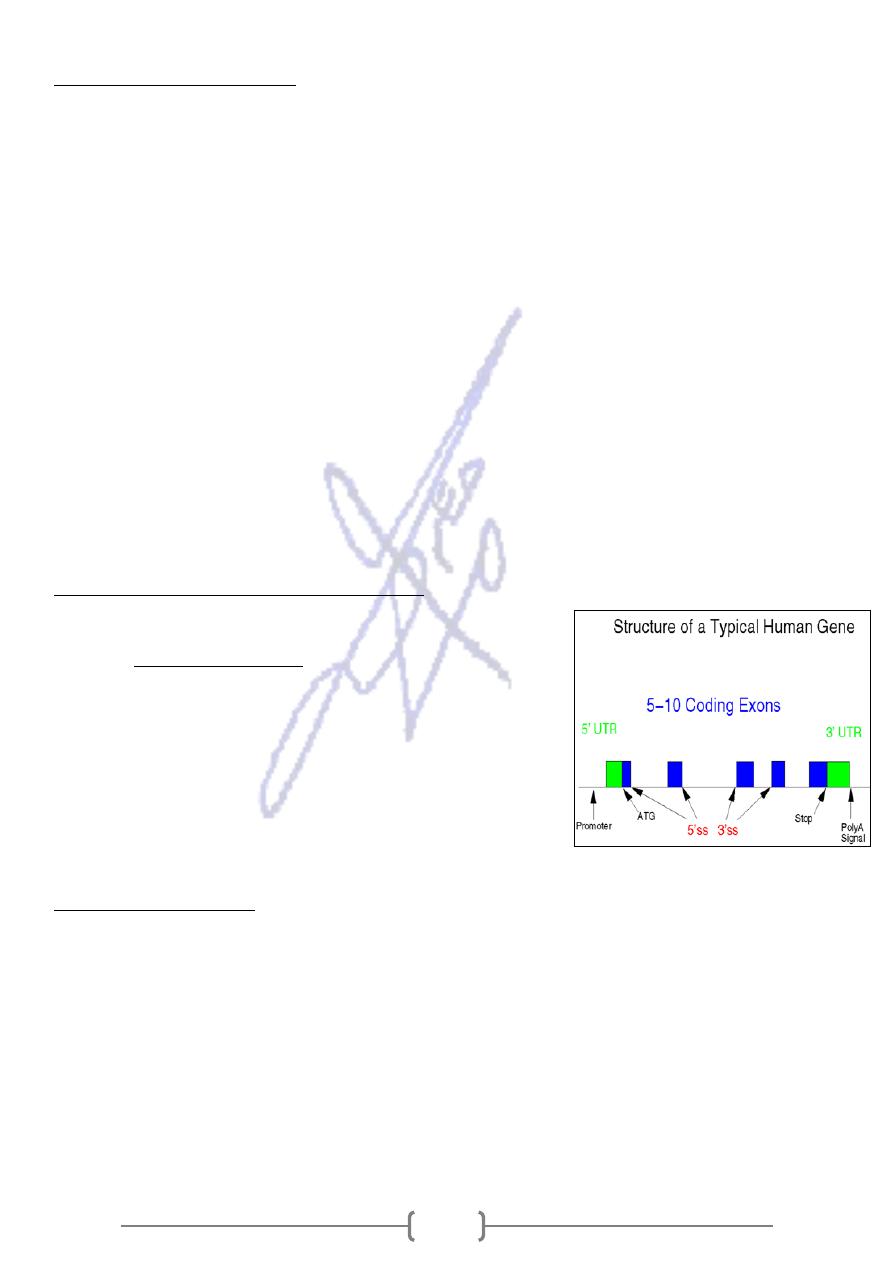
96
Types of RNA molecules
There are three types of RNA, each with a specific function in protein synthesis:
1- Messenger RNA (mRNA): is produced in the nucleus where DNA serves as a template for its
formation. This type of RNA carries genetic information from DNA to the ribosomes in the
cytoplasm where protein synthesis occurs. Messenger RNA is a linear molecule.
2- Ribosomal RNA (rRNA): is produced in the nucleolus of a nucleus where a portion of DNA
serves as a template for its formation. Ribosomal RNA joins with proteins made in the
cytoplasm to form the subunits of ribosomes. The subunits leave the nucleus and come
together in the cytoplasm when protein synthesis is about to begin. Proteins are synthesized at
the ribosomes, they are granules arranged along the endoplasmic reticulum.
* Some ribosomes appear free in the cytoplasm or in clusters called polyribosomes.
3- Transfer RNA (tRNA): is produced in the nucleus, and a portion of DNA also serves as a
template for its production. tRNA transfers amino acids to the ribosomes, where the amino
acids are joined, forming a protein. There are 20 different types of amino acids in proteins;
therefore, there has to be at least this number of tRNAs functioning in the cell. Each type of
tRNA carries only one type of amino acid.
Gene Splicing (Processing of mRNA):
* Most genes in humans are interrupted by segments of DNA
These portions are called
not part of the gene.
that are
introns because they are intragene segments.
* The other portions of the gene are called exons because they
are ultimately expressed.
* Only exons result in a protein product.
* There has been much speculation about the role of
introns. It is possible that they allow crossing-over within a
gene during meiosis.
Processing of mRNA
* When DNA is transcribed, the mRNA contains bases that are complementary to both
exons
and introns, but before the mRNA exits the nucleus, it is processed.
* During processing, the introns are removed, but the exons are left to code for the proteins
and joined to form an mature mRNA molecule consisting of continuous exons.
* In human cells, processing occurs in the nucleus.
* After the mRNA strand is processed, it passes from the cell nucleus into the cytoplasm. There
it becomes associated with the ribosomes.
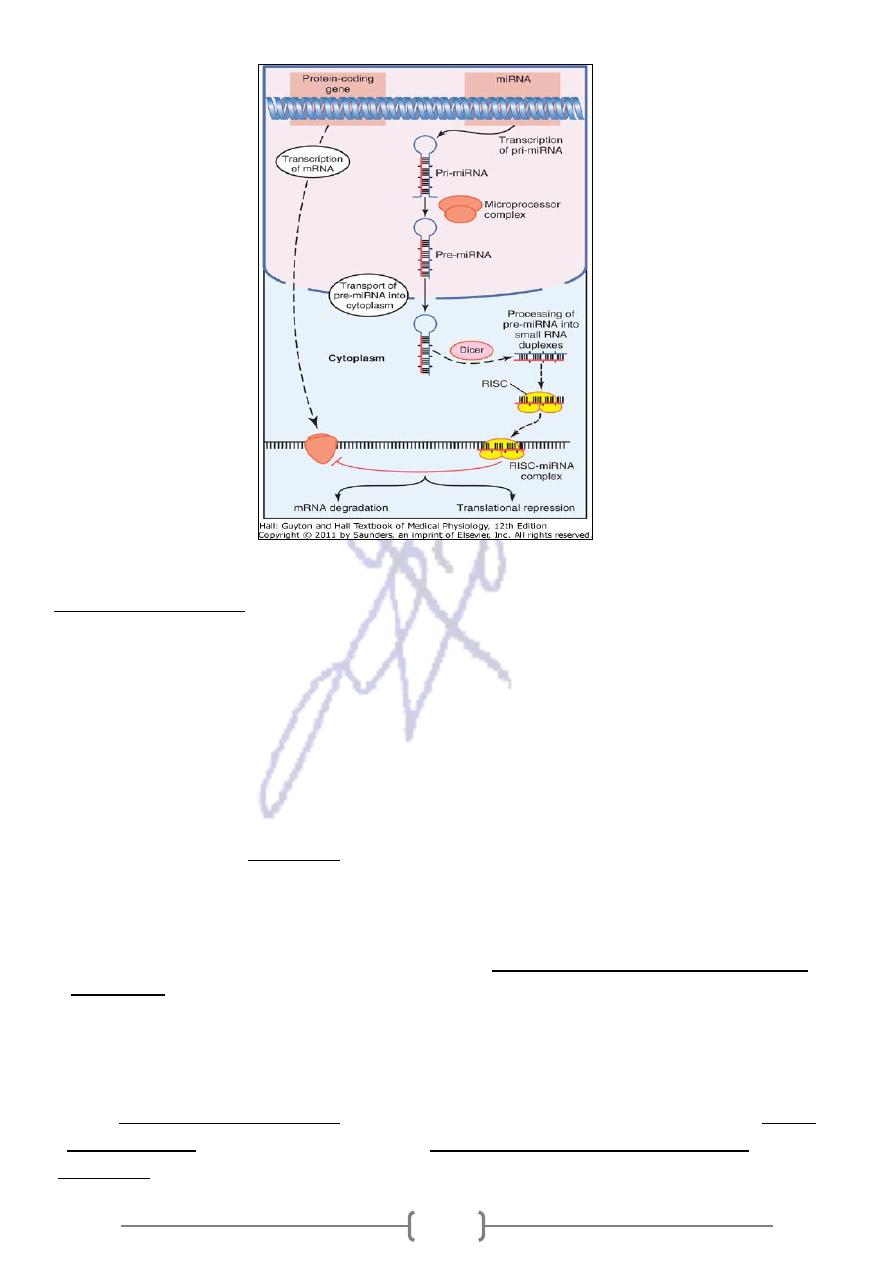
97
The Genetic Code:
* The relationship between the nucleotide sequences of genes and the amino-acid sequences
of proteins is determined by the rules of translation, known collectively as the genetic code.
* Protein is composed of one or more polypeptides, which are in turn composed of sequences
of amino acids. The body contains 20 different types of a.a., and these a.a. are designed by
the DNA after transcription into mRNA.
* Because there are 20 different amino acids and only 4 different RNA bases, so triplet sets of
bases are translated into amino acids, 64 (4×4×4) combinations can be achieved- more than
enough to specify each amino acid.
) represents (code) for one
triplet
every three bases (a
—
triplet code
* So the DNA contains a
amino acid.
* Of the 64 possible codons, 3 signal the end of the coding region known as stop codons. These
are UAA, UGA, and UAG.
more than
most a.a. can be specified by
* The remaining 61 codons all specify amino acids, and
The genetic code is thus said to be "degenerate".
one codon.
* The genetic code is essentially universal. The same codons stand for the same amino acids in
most organisms, from bacteria to humans.
* The exception occurs in mitochondria, which have their own extra nuclear DNA molecules.
mRNA
in which every three bases stand for one amino acid,
DNA contains a triplet code
* While
three bases that also stand for the same
, each of which is made up of
contains codons
amino acid.
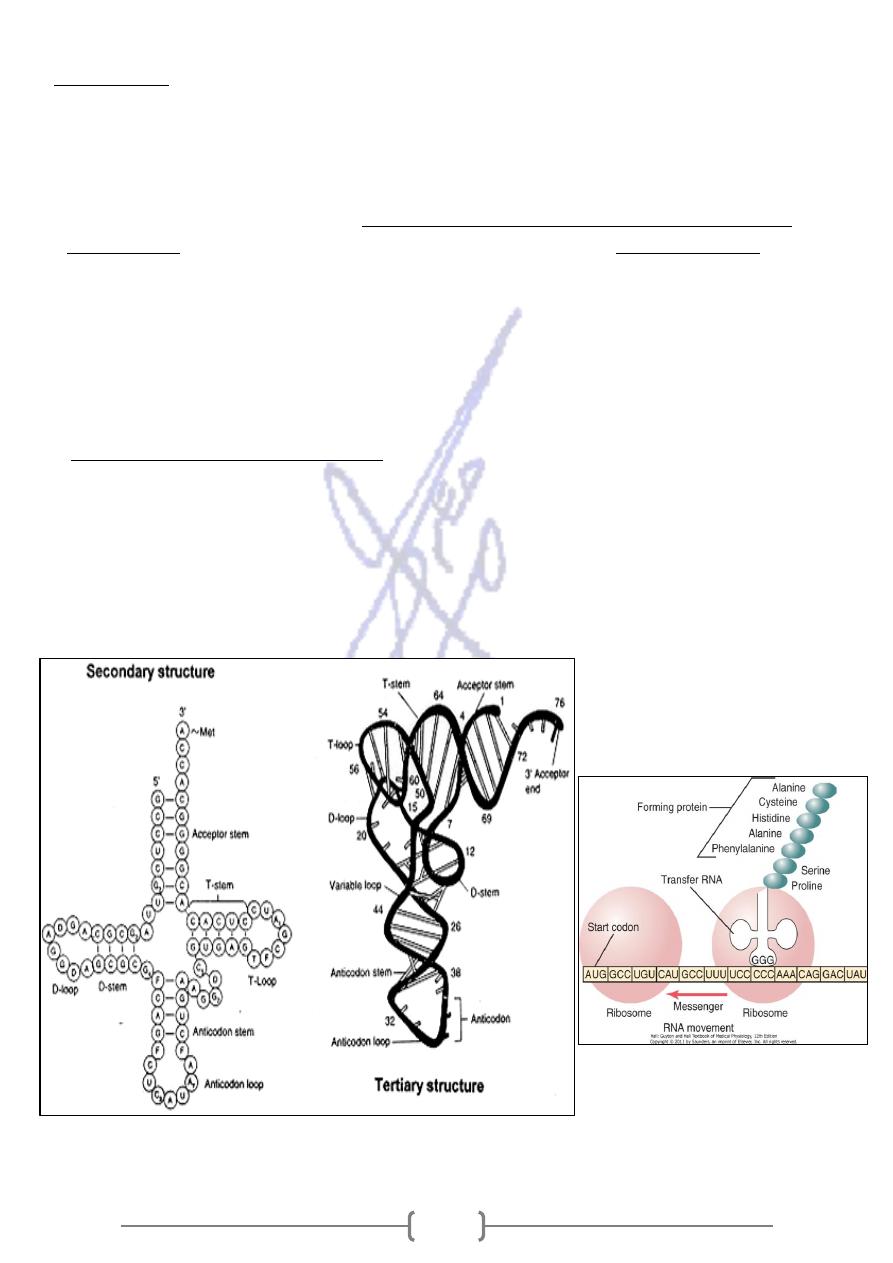
98
Translation:
Translation: Is the process in which mRNA provides a templet for the synthesis of a
polypeptide. mRNA cannot bind directly to amino acids. Instead, it interact with molecules of
transfer RNA (tRNA), which are cloverleaf- shaped RNA strand.
3' end for the attachment of a specific amino acid by a
* Each tRNA molecule has a site at the
called
three nucleotides
. At the opposite end of the cloverleaf is a sequence of
covalent bond
the anticodon.
* The tRNA molecule picks up the amino acid that is complementary to the anticodon
sequence. The anticodon then undergoes complementary base pairing with a appropriate
codon in the mRNA, and the attached amino acid transferred to the polypeptide chain being
synthesize.
* The cytoplasmic site of protein synthesis is the ribosomes, which consist of equal parts of
(rRNA). The function of rRNA is to help bind mRNA
enzymatic proteins and ribosomal RNA
and tRNA to the ribosomes.
* During translation, the ribosomes first bind to an initiation site on the mRNA sequence. The
site consists of a specific codon, (AUG), which specifies the amino acid methionine
* (this amino acid is usually removed from polypeptide before the completion of polypeptide
synthesis).
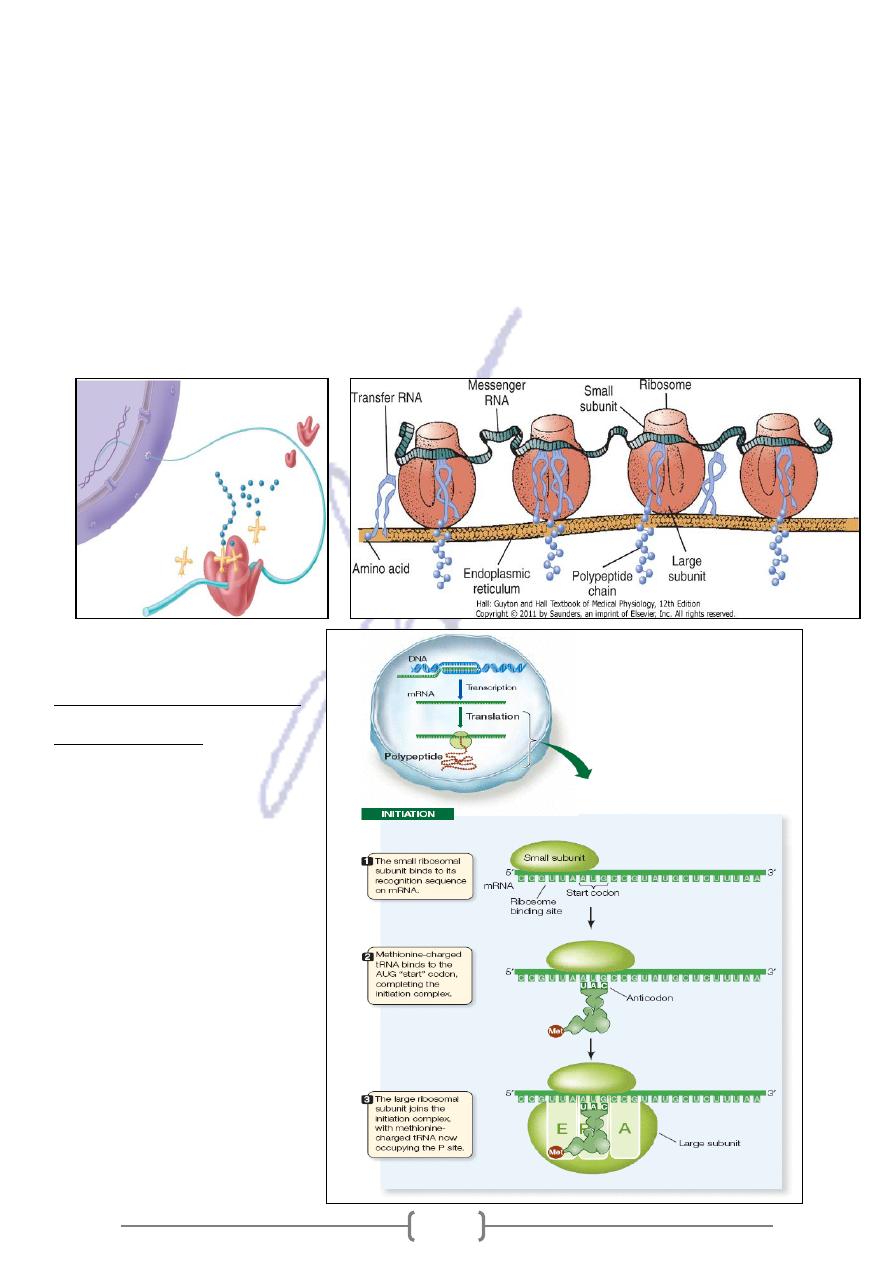
99
* The ribosomes then bind the tRNA to its surface so that base pairing can occur
between tRNA
and mRNA. The ribosomes move along the mRNA sequence, codon by codon in the usual 5'
to 3' direction.
* In this process, the ribosomes provides an enzyme that catalyzes the formation of covalent
peptide bonds between adjacent amino acids, resulting in growing polypeptide
* When the ribosomes arrives at a stop codon on the mRNA sequence (UAA, UGA, and
UAG),
translation and polypeptide formation cease (NH3 terminus of the polypeptide corresponds
to the 5' end of mRNA and COOH terminus corresponds to the 3' end).
* Then the mRNA, the ribosomes, and the polypeptide separate apart and the polypeptides
released into the cytoplasm.
Initiation of Translation
in bacterial cell

111
Review of Gene Expression
1. DNA in the nucleus contains a triplet code. Each group of three bases stands for a specific
amino acid.
2. During transcription, a segment of DNA strand serves as a template for the formation of
mRNA. The bases in mRNA are complementary to those in DNA; every three bases is a codon
for a certain amino acid.
3. Messenger RNA (mRNA) is processed before it leaves the nucleus, during which time the
introns are removed.
4. Messenger RNA (mRNA) carries a sequence of codons to the ribosomes, which are composed of
rRNA and proteins.
5. Transfer RNA (tRNA) molecules, each of which is bounded to a particular amino acid, have
anticodons that pair complementarily to the codons in mRNA.
6. During translation, tRNA molecules and their attached amino acids arrive at the ribosomes,
and the linear sequence of codons of the mRNA determines the order in which the amino acids
become incorporated into a Protein.
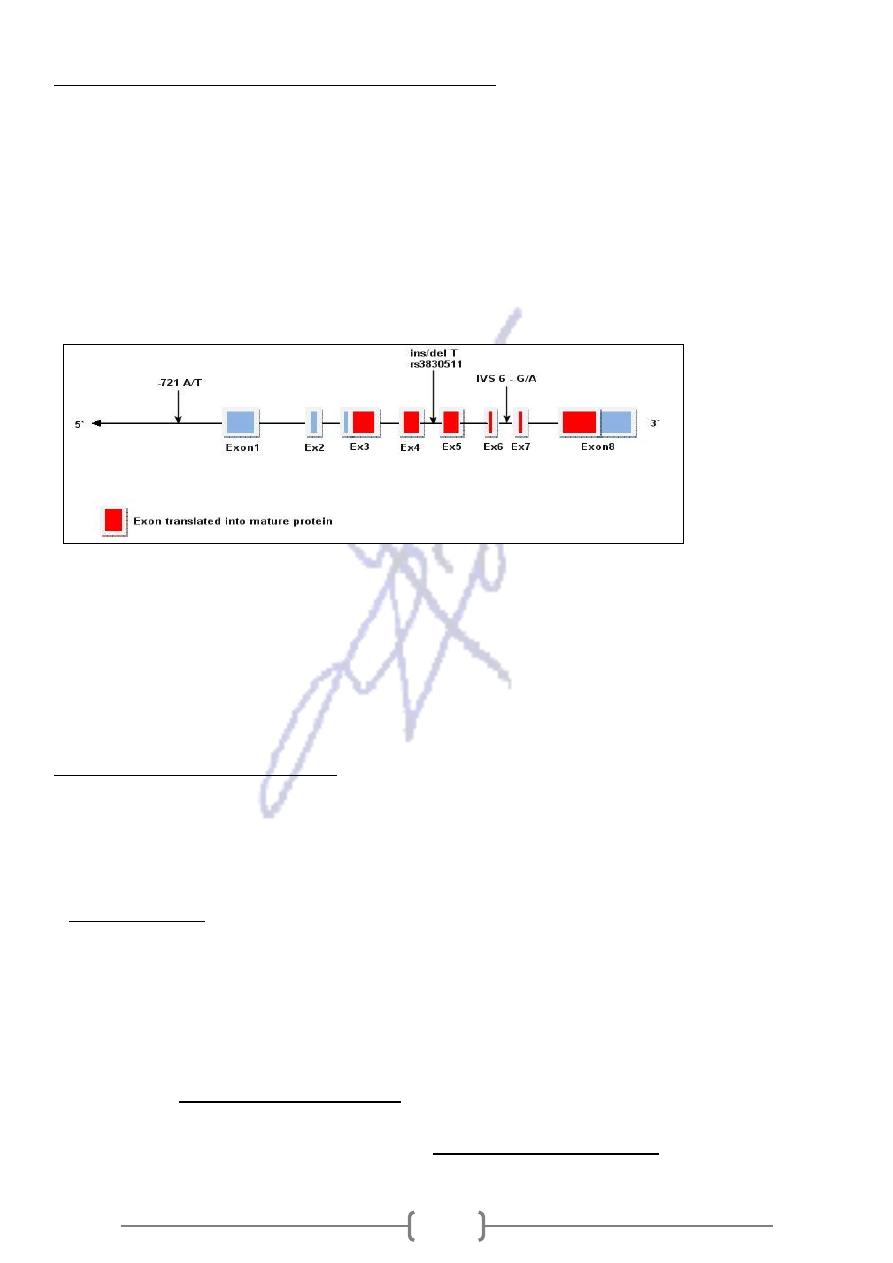
111
Structure of the Gene: Exons and Introns
* The Exon- Intron structure of genes discovered in 1977 that distinguishes eukaryotes from
prokaryotes.
* A typical gene consists of coding and non-coding sequences known as exons and introns,
respectively.
* The exon (coding part) is the code which is transcribed into the mature mRNA and translated
into protein.
* On the other hand non-coding intervening introns are relatively large and form the major
portion of most eukaryotic genes.
* The sequence within introns is random but it can contain regulatory sequences that affect the
splicing mechanism.
* It has also been suggested that introns modified the amount of time required for DNA
replication and transcription.
* The number of introns and exons between genes vary greatly and a gene can consists of
simply two or three exons, but can be up to more than 20 exons.
of DNA
Consensus sequences
* Besides the introns and coding exons, genes also have other regulatory elements that mainly
affect the way how the gene itself is expressed and regulated.
* The 5' and 3' untranslated regions usually consist of sequences that serve this purpose.
* The 5' region ahead of the transcriptional start site usually makes up what is known as the
.
promoter region
* The promoter region consists of sequences such as the TATA box, where RNA polymerase
binds to initiate transcription. Mutation at the TATA element does not prevent initiation of
transcription, but does cause the start point of transcription to be displaced from the normal
position.
* Further upstream there is the CCAAT box which also plays a part in the regulation of
transcription.
that can be found close or sometimes even quite
enhancers or/and silencers
f
* A number o
distant from the gene itself are involved in the regulation of gene expression.
of transcription as
d terminators
regulators an
* Also sequences at the 3' end of the gene act as
well as for polyadenylation of the mRNA molecules
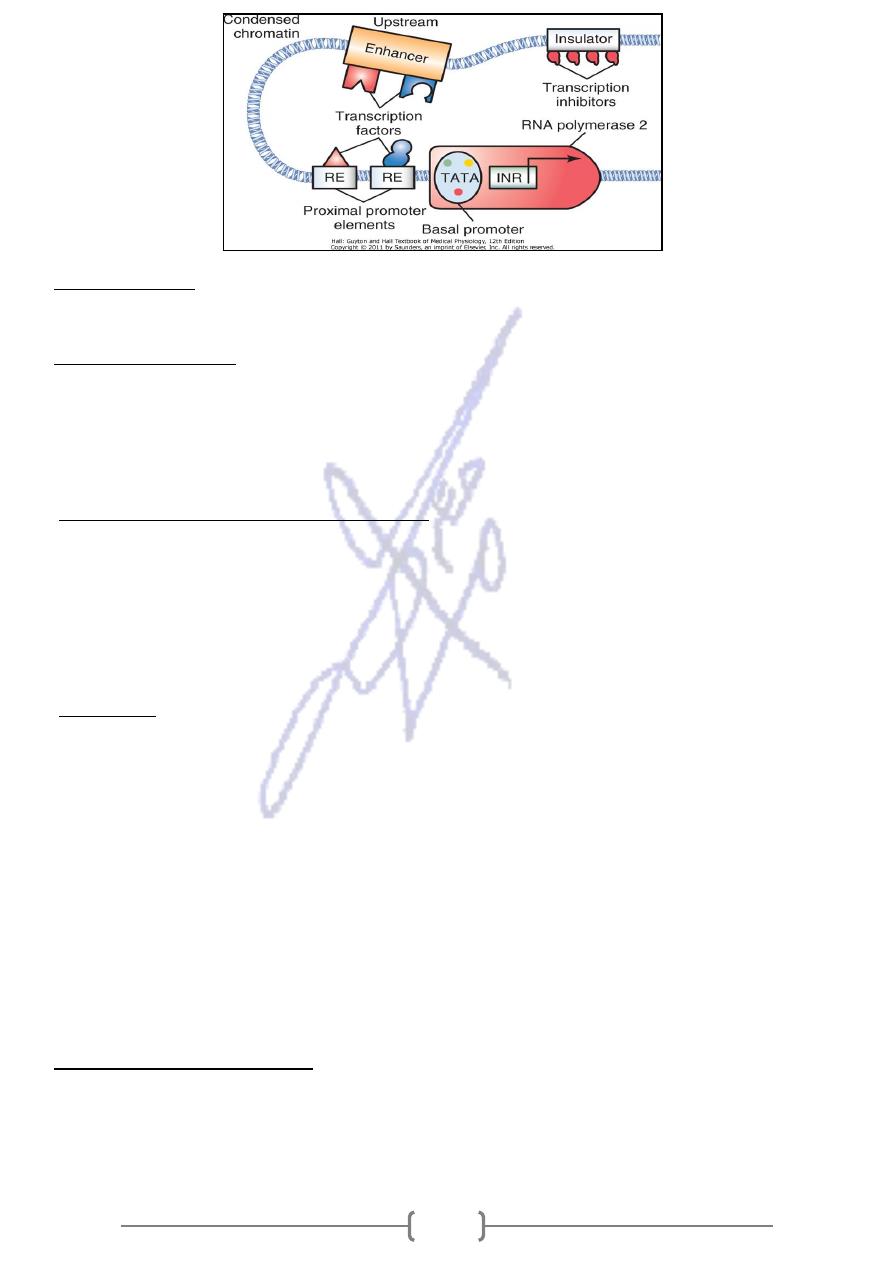
112
Types of DNA
It is important to note that less than 5% of the human genome encode protein.
DNA can classify in to:
* Single- copy DNA: are seen only once in the genome, and comprises about 45% of the
genome and includes the protein- coding genes.
* Highly repetitive DNA: comprise the remaining 55% of the genome, sequences repeated in
the genome, often thousands of times.
There are two major classes of repetitive DNA:
* Dispersed repetitive DNA: account about 45% of the genome, and scattered singly
throughout the genome, they do not occur in tandems.
* Satellite DNA: account about 10% of the genome and found in specific areas on the
chromosomes, such areas include those around the centromere, usually occurring as tandem
repeats.
Telomeres
* Telomere: Another very important structure of the chromosome, which also consists of
repetitive sequences of DNA.
* Telomeres are found at the tips of linear chromosomes. There are telomeric sequences that
consist of short tandem repeats while there are telomere associated sequences found adjacent
to and within the telomere.
* With each cycle of DNA replication these telomeres become shorter and eventually serve
as an internal biological clock for the cell and thus determines its age.
* In germ cells (but not in somatic cells) telomeres are protected by the presence of an RNA-
containing enzyme known as telomerase.
* In immortalised human cancer cells, the activation of telomerase is a very important step in the
transition to malignancy.
The Mitochondrial genome
* The mitochondria are organelles found within eukaryotic cells, thought to be of a prokaryotic
origin that throughout an evolutionary process integrated together as a form of symbiosis.
* In a single cell there are a number of mitochondria that can be up to 1500 in a liver cell.
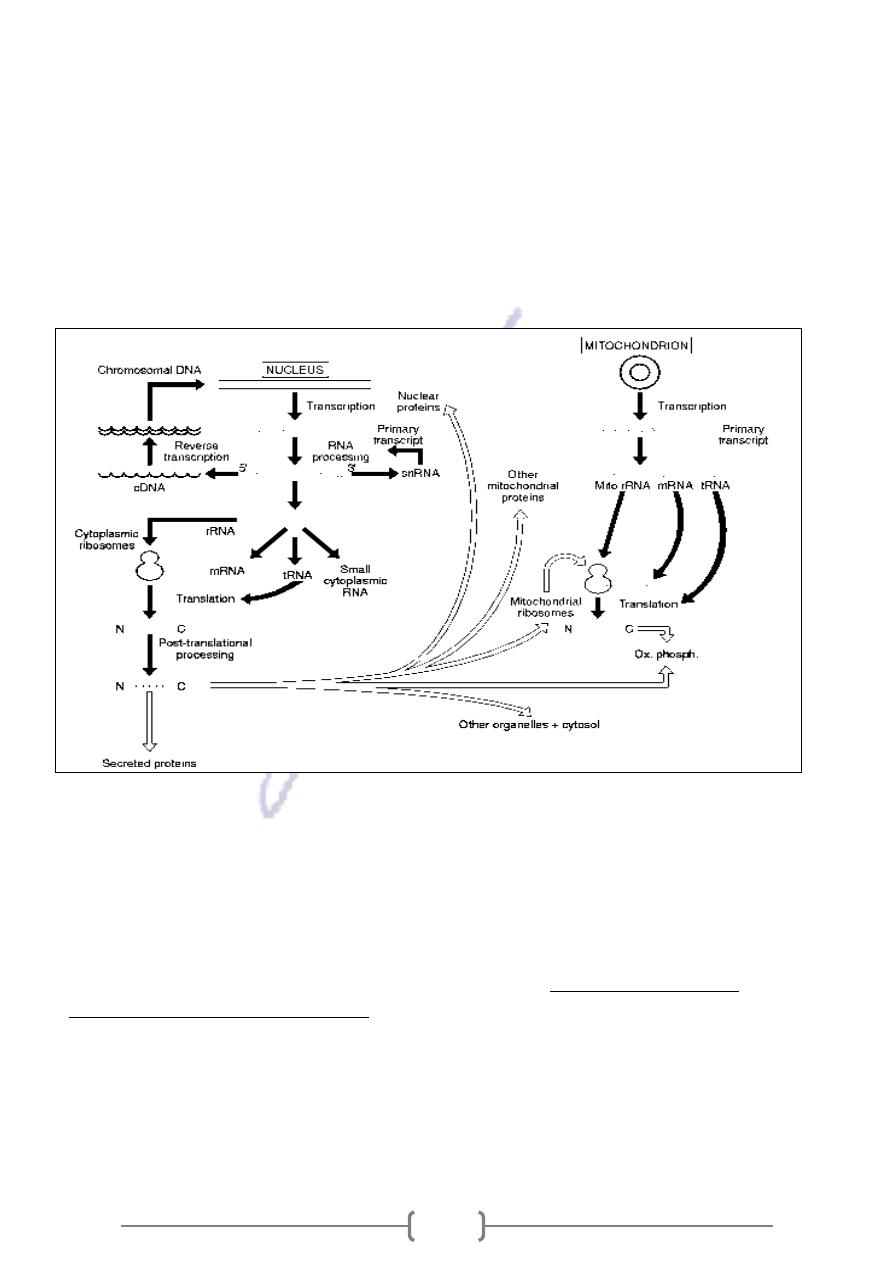
113
* Mitochondria multiply within the cell by division and each mitochondrion has its own genetic
material as well as smaller ribosomes than those found in the cytoplasm.
* The mitochondrial genome consists of 16.6 kb, is circular and encodes for genes such as those
of tRNA, 12s and 16s rRNA and a number of cytochrome c oxidase subunits, cytochrome b,
ATPase subunits and eight protein coding genes.
* The genes encoded on mtDNA does not contain non-coding regions as those on the genomic
DNA
* and both strands are transcribed and translated.
* There are also small variations in the genetic code where some codons code for different
amino acids.
* On the other hand there are genes necessary for mitochondrial functions which are encoded on
the nuclear DNA.
* All these characteristics support the hypothesis that mitochondria originated as a prokaryotic
cell.
* It is now known that variations within the mitochondrial genome can also lead to some
diseases in humans.
* Also mtDNA is usually inherited through the maternal line (with some very rare
sperm cell only has four
copies and the
exceptions) since the oocytes contain multiple
that does not penetrate the oocyte at fertilization.
mitochondria at the neck of the sperm
* Since mtDNA is inherited only from the maternal line and does not usually undergo
recombination and mutations are rare, mtDNA analysis can be used to study origins of
populations through maternal line and also for forensic purposes.
* • Very few mitochondria in sperm
* • Abundant mitochondria in cytoplasm of eggs
* • You have your mother’s mitochondrial genome
